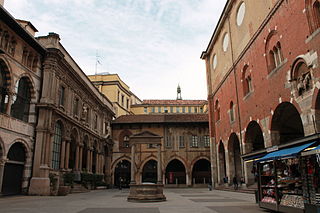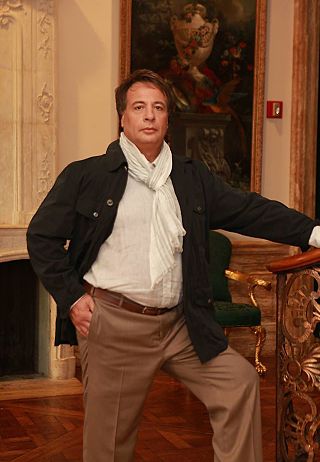| Palazzo Papafava dei Carraresi | |
|---|---|
 | |
| General information | |
| Location | Veneto |
| Town or city | Padua |
| Country | Italy |
Palazzo Papafava dei Carraresi is a palace in Padua, located in the historic center of the city. [1] [2]
| Palazzo Papafava dei Carraresi | |
|---|---|
 | |
| General information | |
| Location | Veneto |
| Town or city | Padua |
| Country | Italy |
Palazzo Papafava dei Carraresi is a palace in Padua, located in the historic center of the city. [1] [2]
It was erected in 1763 by the order of Count Giambattista Trento, in 1805 the property was acquired by inheritance from the Papafava dei Carraresi family.
The palace, of considerable size and of classical prospect, was designed by Giovan Battista Novello. The setting of interior spaces is unusual for the Venetian area: the rooms are organized starting from a large entrance hall with Doric columns on which a Juvarrian stairwell opens. This setting was retained a few years later in the Palazzo Maldura.

Padua is a city and commune in Veneto, northern Italy. Padua is on the river Bacchiglione, west of Venice. It is the capital of the province of Padua. It is also the economic and communications hub of the area. Padua's population is 214,000. The city is sometimes included, with Venice and Treviso, in the Padua-Treviso-Venice Metropolitan Area (PATREVE) which has a population of around 2,600,000.

The Peggy Guggenheim Collection is an art museum on the Grand Canal in the Dorsoduro sestiere of Venice, Italy. It is one of the most visited attractions in Venice. The collection is housed in the Palazzo Venier dei Leoni, an 18th-century palace, which was the home of the American heiress Peggy Guggenheim for three decades. She began displaying her private collection of modern artworks to the public seasonally in 1951. After her death in 1979, it passed to the Solomon R. Guggenheim Foundation, which opened the collection year-round from 1980.

The Palazzo della Ragione is a medieval market hall, town hall and palace of justice building in Padua, in the Veneto region of Italy. The upper floor was dedicated to the town and justice administration; while the ground floor still hosts the historical covered market of the city. The palace separates the two market squares of Piazza delle Erbe from Piazza dei Frutti. It is popularly called "il Salone" . It is part of the UNESCO World Heritage Site of Padua's 14th-century fresco cycles.

The House of Carrara or Carraresi (da Carrara) was an important family of northern Italy in the 12th to 15th centuries. The family held the title of Lords of Padua from 1318 to 1405.

The Palazzo Brignole Sale or Palazzo Rosso is a house museum located in Via Garibaldi, in the historical center of Genoa, in Northwestern Italy. The palace is part of the UNESCO World Heritage Site Genoa: Le Strade Nuove and the system of the Palazzi dei Rolli. The rich art collection inside, along with the galleries of Palazzo Bianco and Palazzo Doria Tursi, is part of the Musei di Strada Nuova and consists of the works of artists of the caliber of Antoon van Dyck, Guido Reni, Paolo Veronese, Guercino, Gregorio De Ferrari, Albrecht Dürer, Bernardo Strozzi and Mattia Preti.

The Palazzo Pretorio or Palazzo dei Provveditori veneti is a palace in Cividale del Friuli, northern Italy, attributed to the architect Andrea Palladio and built between 1565 and 1586. Since 1990 it is the home of the National Archeological Museum of Cividale.

The Accademia Galileiana is a learned society in the city of Padua in Italy. The full name of the society is Accademia galileiana di scienze, lettere ed arti in Padova. It was founded as the Accademia dei Ricovrati in Padua in 1599, on the initiative of a Venetian nobleman, Federico Cornaro. The original members were professors in the University of Padua such as professor Georgios Kalafatis; one of its original members was Galileo Galilei. In 1779 the academy merged with the Accademia di Arte Agraria and became the Accademia di Scienze Lettere e Arti; in 1949 it became the Accademia Patavina di Scienze, Lettere ed Arti; its name was changed to Accademia Galileiana di Scienze, Lettere ed Arti in Padova in 1997, in honor of Galileo. The academy is lodged in the Carraresi Palace in Padua.

Salaborsa is the main public library in Bologna, region of Emilia-Romagna, Italy.

Piazza Mercanti is a central city square of Milan, Italy. It is located between Piazza del Duomo, which marks the centre of the modern city of Milan, and Piazza Cordusio, and it used to be the heart of the city in the Middle Ages. At the time, the square was larger than it is now and known as "Piazza del Broletto", after the "Broletto Nuovo", the palace that occupied the centre of the square. In the 13th century, there were six entry points to the square, each associated to a specific trade, from sword blacksmiths to hat makers.

The Biblioteca Nazionale Braidense or Braidense National Library, usually known as the Biblioteca di Brera, is a public library in Milan, in northern Italy. It is one of the largest libraries in Italy. Initially, it contained large historical and scientific collections before it was charged with the legal deposit of all publications from Milan. Since 1880, it has had the status of a national library and is today one of the 47 Italian State libraries.

Piazza delle Erbe is one of the many squares in the historic center of Padua. For centuries, with Piazza della Frutta, it was the commercial center of the city. In the two squares is one of the largest markets in Italy. Unlike Piazza dei Signori, the civic theater of celebrations, Piazza delle Erbe was the site of the folk festivities. The square is dominated by the imposing Palazzo della Ragione.

The Museo Nazionale Atestino is a mainly archeologic museum, displaying pre-Roman and Roman art and artifacts found in and around the town of Este in the province of Padova, region of Veneto, Italy.
Palazzo Maldura is a Padua civilian building, now the home of the Department of Language Studies and Literature at the University of Padua.

The Papafava were an aristocratic family of Padua, a junior branch of the Carraresi. It was admitted into the Venetian patriciate among the so-called Houses Made for Money.

The Palazzo Pesaro Orfei or Palazzo Pesaro degli Orfei is a historic palace in Venice, in northern Italy. It was built by the Pesaro family in the fifteenth century in Venetian Gothic style. From 1902 it was the home of Mariano Fortuny and his wife Henriette Negrin. It now houses the Museo Fortuny, and may also be called Palazzo Fortuny.

Torre dell'Orologio is a clock tower located in the Piazza (Plaza) Dei Signori and positioned between the Palazzo (Palace) del Capitanio and the Palazzo dei Camerlenghi in Padua, or Padova, Italy. It is also referred to as the astronomical clock of Padua.

The San Michele Oratory or Oratory of San Michele is an oratory chapel in Padova, Italy. The interior is painted with a cycle of frescoes on the life of the Virgin Mary by Jacopo da Verona.

Minerva between Geometry and Arithmetic is a 1550 fresco fragment, usually attributed to Paolo Veronese but by some art historians to Anselmo Canera or Giambattista Zelotti. It was painted for the Palazzo de Soranzi in Castelfranco Veneto but now in the Palazzo Balbi in Venice.

Alexander Kanevsky is a Russian painter and sculptor, naturalized American.
45°24′18″N11°52′23″E / 45.40499°N 11.87314°E